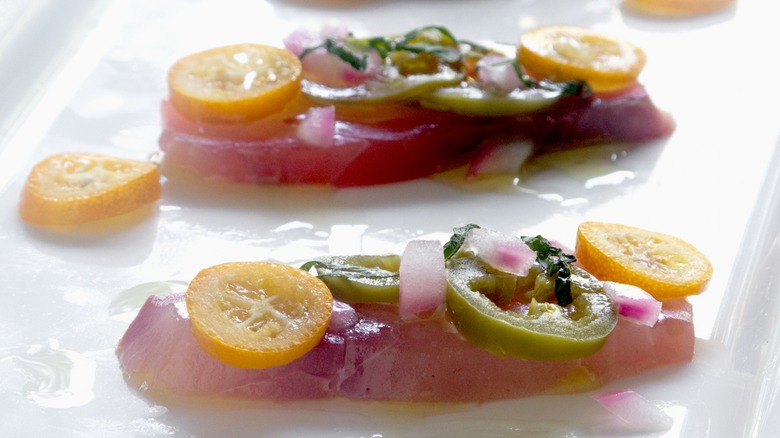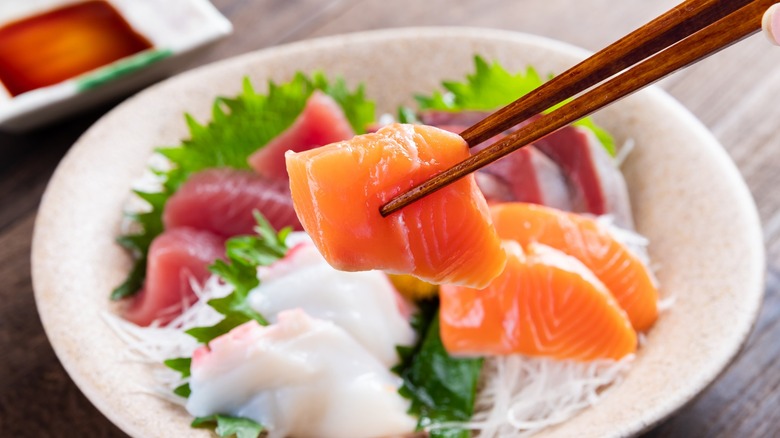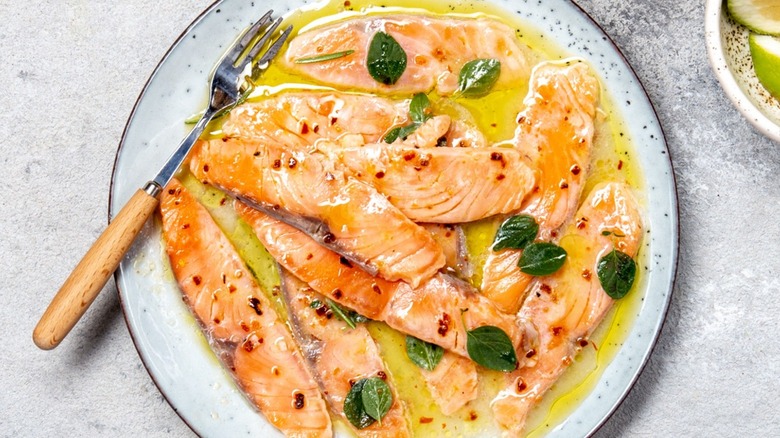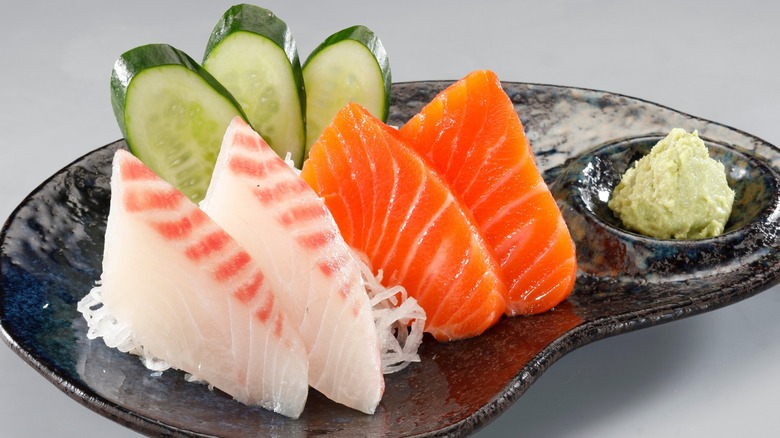What's The Difference Between Crudo And Sashimi?
Fish is delicious in many forms, but when sourced carefully, there's a special appeal to a raw bite. With its aesthetic appearance and myriad possibilities, it's no surprise that sushi is the most famous vessel for raw fish. Yet, while these rolled rice creations are tasty, it's just the tip of the iceberg for fresh-out-of-the-sea options. Many cuisines have their own rendition of highlighting high-caliber raw seafood, from Hawaii's poke to Peru's tiradito.
So, for two styles that most minimally process the source ingredients, turn to crudo and sashimi. The former hails from southern Europe, while the latter is Japan's other famous seafood creation. The two dishes have a whole lot in common, most notably that they minimally alter very fresh meat ingredients to showcase its flavor.
Yet, in their details, each method highlights distinct culinary inflections. Crudo is all about combining a few, yet highly aromatic, ingredients alongside a chosen base. Meanwhile, sashimi uses minimal ingredients and relies exclusively on technique, with each knife stroke being key to its simple but meticulous preparation. Such differentiations demonstrate the expansive possibility of enjoying raw food.
What is crudo?
Crudo, which translates to "raw" in Spanish and Italian, hails from the Mediterranean region. The term references a low-intervention style of cooking in which a high-quality protein is cut up and drizzled with sauce. It's especially popular in coastal Italian villages, where the abundant fresh sea catch is served simply and quickly alongside an arrangement of local ingredients.
An especially famous rendition of the dish is carpaccio, which is composed of sliced or pounded fish, beef, or vegetables. In this style, the prepared component is shaved as thin as possible and is typically covered with olive oil and lemon juice and served with a garnish.
Nowadays, crudo comes in a range of flavor palates and preparations, with chefs using the base as a canvas for a wide variety of creative interpretations. Many layer additional toppings, sauces, and flavors atop the raw meat base. Regardless of the exact ingredient combination, the dish always comes together quickly. In fact, raw fish will start to cook when citrus or other acids are used as toppings, so it's meant to be eaten right away.
What is sashimi?
Delicious sashimi is a Japanese style of preparation used to highlight raw ingredients. Sashimi is similar to sushi but is crafted sans rice, accompanied by only a bit of wasabi, soy sauce, or ponzu. Complex marinades, sauces, and ingredient combinations are absent; instead, the focus is on the cut's intrinsic flavor.
Fish is the most popular variety of sashimi and is most commonly associated with the dish. Types of fish with especially firm meat work best, such as bluefin tuna called maguro — found in varying grades of fattiness — as well as amberjack, bonito, yellowtail, and flounder. However, salmon and mackerel are also frequently used for sashimi. It's also made with shrimp, scallops, other seafood items, and occasionally other meats.
In addition to thoughtful sourcing and butchering — "sashimi" means "pierced body" in Japanese – sashimi's appeal lies in its presentation. Pieces are aesthetically arranged on a plate, oftentimes in odd numbers. There's thoughtful avoidance of overcrowding, and simple garnishes add a dash of color. The sashimi is then eaten with chopsticks, oftentimes as a standalone course that's part of a larger meal. Such a serving style allows diners to focus on each individual bite of fish.
Crudo has more components than sashimi
Crudo is a far more expansive preparation style than sashimi. Eaten across multiple cuisines in Europe for centuries and now becoming popular in restaurant scenes elsewhere, it's a dish without a definite culinary affiliation. There's also a tremendous variation in base: fish, meats, and even vegetables can all form its principal foundation. When prepared with seafood, crudo overlaps with sashimi, using similar bases of tuna, hamachi, scallops, and salmon.
However, crudo chefs are more willing to throw other cuts into the style, too, like grouper, bass, rockfish, and others. Not to mention that it involves options rarely considered for sashimi, like the beef employed in carpaccio or a vegan radish and cucumber medley. Unlike sashimi, wide-ranging toppings, sauces, and flavors are also melded into a crudo. While olive oil, lemon, and perhaps some herbs represent the classic preparation, the sky is the limit for modern crudo sauces and toppings.
From citrus additions like oranges and tangerines to tomatoes, peppers, melon, and avocado, many different vegetables and fruits are ripe for use in crudo. Plus, there's room to experiment with the employed oil — whether it's sesame or nut-based — rather than sticking to simple olive oil. And as a final garnish, expect to find various herbs, from basil to mint, and spices for a dash of flavor. Such open-ended creativity is the appeal of crudo; it allows many flavors to play alongside freshly sourced raw ingredients.
Sashimi is sliced into specific shapes
When it comes to preparing crudo, there's no guidance or tradition regarding how the protein is sliced — the shape is completely up to the chef. However, sashimi is a stark contrast; the method of slicing the fish into preferred shapes and sizes requires specialized knives and follows a detailed order of steps. The most common technique is hira-zukuri, which starts from a block of meaty fish like tuna and salmon. The filets are sliced against the grain into rectangular pieces around half an inch thick, creating the most commonly enjoyed sashimi style.
For white-fleshed fish, however, the cutting method is different. Since the lighter meat can be chewy if improperly prepared, the fish is cut at a 40-degree angle into narrow slices in a technique called sogi-zukuri. Some white fish, like sea bream, is cut even thinner into 1/16th-inch thick pieces through the method of usu-zukuri.
Similar specialty cuts also involve other seafood. For squid, ito-zukuri is the employed method, which creates thin, slender, long strips. And shrimp are deftly butterflied, making them more palatable for a single bite. Such specialization is the essential character of sashimi; precise cuts yield perfectly tender, flavorful results.




